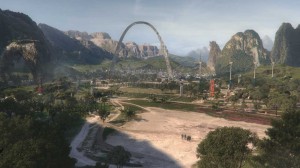
If you factor in all the 2D effects – like glowing weapons and muzzle flashes and the routine cleanup and fixes customary of sci-fi CG effects – the workload was more than 1,500 effects, not including the many iterations and modifications they made to the 3D creatures and visual effects following reviews.
“The visual effects challenge on Defiance is to transport viewers to an imaginary, hybrid place that juxtaposes life on Earth with a strange, bizarre new world,” said Gary Hutzel, visual effects supervisor for Defiance. “To successfully immerse viewers in Defiance, our virtual environments needed to support the imaginative plot by strategically employing extremely credible effects.”
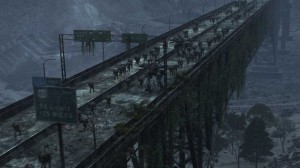 Since Defiance is essentially located over the top of what was once St. Louis, Miss. the cityscape is dotted with recognizable St. Louis skyscrapers and other vestiges of modern life. But the Defiance locale also has an infusion of Votanis alien cultures and technology. Viewers quickly become acquainted with the many mutant life forms, such as sabre wolves and Hellbugs that spawned after disgruntled Votans deliberately detonated their advanced Ark Sphere weapons on Earth, which drastically altered Earth’s biosphere.
Since Defiance is essentially located over the top of what was once St. Louis, Miss. the cityscape is dotted with recognizable St. Louis skyscrapers and other vestiges of modern life. But the Defiance locale also has an infusion of Votanis alien cultures and technology. Viewers quickly become acquainted with the many mutant life forms, such as sabre wolves and Hellbugs that spawned after disgruntled Votans deliberately detonated their advanced Ark Sphere weapons on Earth, which drastically altered Earth’s biosphere.
According to CG artist Sean Jackson, the CG team could not have created all these visual effects without LightWave.
“We would’ve been dealing with hundreds of millions of polygons,” added CG artist Jesse Toves. “It would’ve been a nightmare.”
In creating cinema-quality visual effects on a TV show budget and production schedule, both Toves and Jackson cite several LightWave capabilities that made all the difference in their productivity. LightWave’s intuitive Modeler enabled the animators to quickly rig 3D hero creatures from scratch.
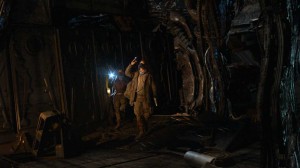 “Whenever a creature needed to do something specific, like climb up the side of a rocky cliff or get shot and fall over, we animated it by hand,” said Toves. “But if we needed an army of robotic Volge mercenaries marching over a bridge or 50 of them running through a valley – where their numbers mattered more than the specific performance – we would use Instancing to achieve that effect.”
“Whenever a creature needed to do something specific, like climb up the side of a rocky cliff or get shot and fall over, we animated it by hand,” said Toves. “But if we needed an army of robotic Volge mercenaries marching over a bridge or 50 of them running through a valley – where their numbers mattered more than the specific performance – we would use Instancing to achieve that effect.”
Defiance depends heavily on virtual environments and beauty shots to convey the size of the town and its geographic surroundings. When the production was not shooting on the back lot, the actors and crew worked in large greenscreen studios. Since it was difficult for the actors to know how to react to creatures or other threats that were not physically there, detailed animated sequences were provided to the director and actors so they could pre-visualize the CG elements that would eventually be added to the scene. For the attack of the Volge, a group of actors were standing on a rocky mound in the middle of a greenscreen studio. Pre-viz elements helped them understand how to react and where to fire their weapons.
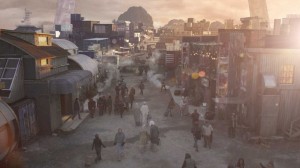 “Because we had so many virtual elements to create in such a short span of time, we were able to import and repurpose 3D objects from the digital library we amassed over the years while working on previous sci-fi shows like Battlestar Gallactica, BSG: Blood and Chrome, and others,” said Hutzel. “LightWave enables us to modify existing 3D objects, even ones created using older LightWave versions, rather than always having to start from scratch. That capability – which is not widely offered on other major 3D animation platforms – proved to be a tremendous time-saver.”
“Because we had so many virtual elements to create in such a short span of time, we were able to import and repurpose 3D objects from the digital library we amassed over the years while working on previous sci-fi shows like Battlestar Gallactica, BSG: Blood and Chrome, and others,” said Hutzel. “LightWave enables us to modify existing 3D objects, even ones created using older LightWave versions, rather than always having to start from scratch. That capability – which is not widely offered on other major 3D animation platforms – proved to be a tremendous time-saver.”
Besides fast rendering, LightWave’s Viewport Preview Renderer (VPR) was critical to evaluating CG effects and lighting setups before committing to them in the rendering process. “Lighting is critical to matching the CG scene with live-action plates and making the viewer believe the illusion is real,” Jackson said. Besides LightWave’s lighting and radiosity tools, the team used 3D modeling, Fiber FX for hair and fur, soft body dynamics, Instancing, and HyperVoxels for volumetric fluid effects like slime cascading off the matron Hellbug.
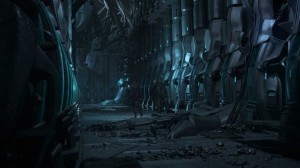 Fine detail and textures were added to creatures in Pixologic’s ZBrush and that data was output directly into the LightWave content directory, ready for animators to use. In addition, hundreds of live action plates and LightWave 3D objects were combined in After Effects for 2D enhancements and/or compositing.
Fine detail and textures were added to creatures in Pixologic’s ZBrush and that data was output directly into the LightWave content directory, ready for animators to use. In addition, hundreds of live action plates and LightWave 3D objects were combined in After Effects for 2D enhancements and/or compositing.
“The speed and versatility of LightWave was indispensable throughout this entire process, but especially when we needed to revise or change anything we created,” said Jackson. “For a CG scene known as the Glyph Chamber, I went through 14 revisions of that asset within a week and a half. Sometimes changes are minor, but at other times, they can be drastic. Either way, they need to be turned around quickly and that’s what LightWave enables us to do.”
Defiance is currently in production on a second season slated for June 2014.





